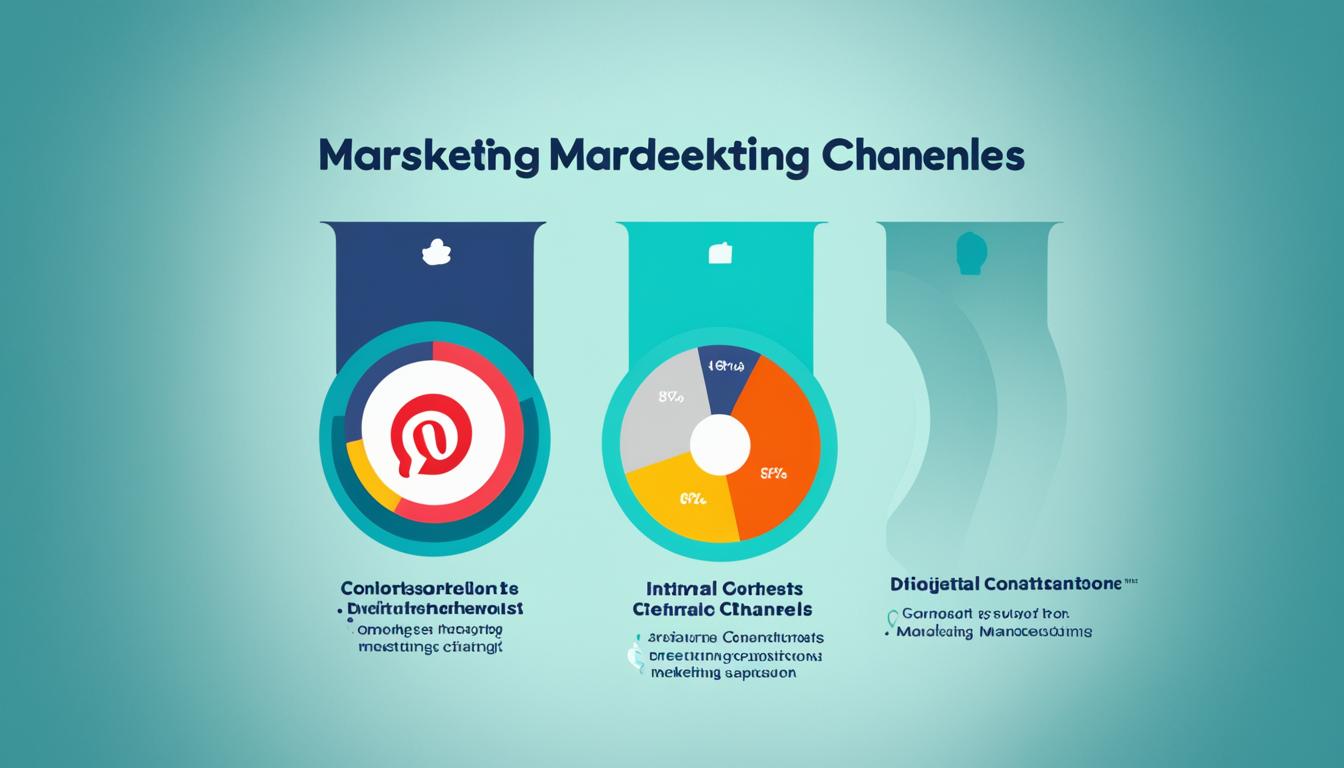Service marketing and product marketing are two distinct approaches in the field of marketing. Service marketing involves promoting intangible services to customers, while product marketing focuses on marketing physical products. These two strategies have unique differences, with service marketing focusing on understanding the target audience and creating effective messaging, and product marketing concentrating on driving demand, improving sales, and differentiating products from competitors. Both service marketing and product marketing have their own set of strategies and benefits, which we will explore further in this guide.
Key Takeaways:
- Service marketing involves promoting intangible services, while product marketing focuses on marketing physical products.
- Service marketing strategies revolve around understanding the target audience and creating effective messaging, while product marketing strategies focus on driving demand and differentiating products.
- Service marketing aims to deliver personalized experiences and build customer loyalty, while product marketing aims to boost revenue and establish brand recognition.
- Both service marketing and product marketing are essential components of a comprehensive marketing strategy.
- Understanding the differences between service marketing and product marketing can help businesses effectively market their offerings and achieve their marketing goals.
What is Product Marketing?
Product marketing is the process of bringing a product to market, promoting it, and selling it to a customer. It involves understanding the product’s target audience, strategically positioning the product, and creating messaging that appeals to the audience. The goal of product marketing is to boost revenue and demand for the product by effectively marketing its features and benefits. Product marketing is a strategic component of conventional marketing, focusing specifically on the product and its impact on sales and revenue.
Product marketing plays a critical role in ensuring the success of a product in the market. It involves the implementation of various strategies and tactics to bring a product to the attention of the target audience and encourage them to make a purchase. By understanding the needs and preferences of the product’s target audience, product marketers can develop messaging and positioning that resonates with potential customers, effectively promoting the product’s unique value proposition.
One of the key aspects of product marketing is identifying the product’s target audience. This involves conducting market research and gathering insights to understand the characteristics, preferences, and behaviors of the people who are most likely to be interested in the product. By understanding the target audience, product marketers can tailor their marketing efforts towards reaching and engaging with these individuals effectively.
Strategic positioning is another crucial element of product marketing. It involves determining how the product should be positioned in the market to differentiate it from competitors and appeal to the target audience. This includes identifying the product’s unique selling points, understanding its competitive advantages, and highlighting its benefits and features in a compelling way.
To promote and sell a product successfully, effective marketing and promotional strategies are essential. Product marketers utilize various channels and tactics to create awareness, generate interest, and drive demand for the product. This can include digital marketing campaigns, social media advertising, content marketing, influencer partnerships, and more. The goal is to reach the target audience and convince them of the value and benefits of the product, ultimately leading to increased sales and revenue.
Product marketing also involves continuous monitoring and evaluation to assess the effectiveness of marketing efforts and make necessary adjustments. By analyzing key metrics and feedback from customers, product marketers can gather insights that help optimize marketing strategies and improve the overall performance of the product in the market.
In summary, product marketing is a critical component of a company’s marketing strategy. It involves the process of bringing a product to market, promoting it, and selling it to customers. By understanding the product’s target audience, strategically positioning it, and effectively marketing its features and benefits, product marketing helps boost revenue and demand for the product.
Differences Between Product Marketing and Conventional Marketing
While product marketing is a component of conventional marketing, there are distinct differences between the two. Conventional marketing encompasses a broader range of topics, including lead generation, SEO, and overall brand promotion. It focuses on implementing the seven Ps of marketing, which are product, price, place, promotion, people, process, and physical evidence. Conventional marketing efforts aim to build a comprehensive marketing strategy that covers various aspects of the business.
On the other hand, product marketing zooms in on understanding the target audience for a specific product. It involves delving deep into the audience’s preferences, needs, and behaviors to develop effective messaging and positioning that resonates with them. Product marketing also encompasses the launch and execution of a product, ensuring that it reaches the right audience and achieves success in the market. It lies at the core of a company’s marketing, sales, and product teams, driving the efforts behind bringing a product to market.
While conventional marketing addresses broader marketing objectives, product marketing focuses specifically on understanding the audience, developing messaging, and executing launches for individual products. Both approaches are vital components of a well-rounded marketing strategy, playing complementary roles in driving business success.
Product Marketing Goals
Product marketing encompasses a set of goals aimed at driving demand, adoption, and sales of a particular product. These goals revolve around key aspects of product marketing, including understanding customers, targeting buyer personas, learning about competitors, aligning marketing, product, and sales teams, positioning the product effectively in the market, and ultimately boosting revenue and improving sales.
Driving Demand and Adoption
One of the primary goals of product marketing is to generate demand for a product and encourage its adoption among existing customers. By utilizing various marketing strategies, product marketers strive to create awareness, generate interest, and entice customers to purchase and use the product.
Understanding Customers Better
To effectively market a product, it is crucial to have a deep understanding of the target customers. Product marketers invest time in gathering customer insights, conducting market research, and analyzing customer behavior to gain valuable insights that can inform marketing strategies and tactics.
Targeting Buyer Personas
Product marketing aims to target specific buyer personas, which represent ideal customers for the product. By creating buyer personas, product marketers can tailor their messaging, positioning, and marketing efforts to resonate with the target audience, increasing the likelihood of customer engagement and conversion.
Learning About Competitors
To gain a competitive edge, product marketers focus on understanding the market landscape and their competitors. By conducting competitor analysis and gathering market intelligence, they can identify strengths, weaknesses, and unique selling points of competing products, allowing them to position their product effectively and differentiate it from competitors.
Aligning Marketing, Product, and Sales Teams
Product marketing plays a crucial role in ensuring alignment between the marketing, product, and sales teams. By collaborating closely with these teams, product marketers facilitate effective communication, share customer insights, and ensure that marketing strategies and messaging align with the product’s features and benefits, resulting in cohesive and impactful go-to-market strategies.
Positioning the Product in the Market
Another key goal of product marketing is to position the product effectively in the market. This involves identifying the product’s unique value proposition, differentiating it from competitors, and crafting compelling messaging that highlights its benefits and resonates with the target audience.
Boosting Revenue and Improving Sales
Ultimately, product marketing aims to drive revenue growth and improve sales performance. By executing effective product marketing strategies, product marketers can increase customer acquisition, retention, and overall sales, contributing to the overall success and profitability of the product and the business.
| Product Marketing Goals | Action Items |
|---|---|
| Driving demand and adoption of the product | Create awareness campaigns, offer incentives, and highlight product benefits |
| Understanding customers better | Conduct market research, gather customer insights, and analyze customer behavior |
| Targeting buyer personas | Create buyer personas, tailor marketing messages, and segment the target audience |
| Learning about competitors | Conduct competitor analysis, gather market intelligence, and identify unique selling points |
| Aligning marketing, product, and sales teams | Collaborate closely, share customer insights, and ensure cohesive go-to-market strategies |
| Positioning the product in the market | Identify unique value proposition, differentiate from competitors, and craft compelling messaging |
| Boosting revenue and improving sales | Execute effective product marketing strategies, increase customer acquisition and retention |
Importance of Product Marketing
Product marketing plays a pivotal role in the success of any business. It focuses on highlighting the product itself to ensure its longevity in the market. By effectively marketing the product, product marketers create excitement among consumers, encourage purchases, and drive sales. Through targeted content creation, product marketers can captivate the interest of the target audience, effectively communicating the value and benefits of the product.
A key aspect of product marketing is conducting thorough customer research. By understanding the needs and preferences of the target audience, product marketers can develop innovative products and optimize their success in the market. This customer-centric approach enables businesses to align their products with market demand, thereby driving sales and enhancing customer satisfaction.
Furthermore, product marketing serves as a bridge between the product development team and the target audience. By conveying the unique selling propositions and features of the product, product marketers create a compelling narrative that sets the product apart from competitors. This differentiation not only increases the chances of purchase but also establishes brand recognition and loyalty.
Overall, product marketing plays a vital role in driving the success of a product by targeting the right audience, creating excitement, and encouraging purchase. By leveraging customer research and engaging content creation, product marketers are instrumental in driving sales and ensuring the long-term success of the product in the market.
Product Marketing Responsibilities
Product marketers play a crucial role in the success of a product. Their responsibilities encompass a wide range of tasks, all aimed at effectively marketing the product and ensuring its relevance in the market.
Identifying Buyer Personas
One of the primary responsibilities of product marketers is to identify the buyer personas for the product. This involves conducting market research, analyzing customer data, and understanding the needs and preferences of the target audience. By identifying the buyer personas, product marketers can tailor their marketing strategies to effectively reach and engage potential customers.
Creating Product Marketing Strategy
Product marketers are responsible for creating a comprehensive product marketing strategy. This includes identifying the key features and benefits of the product, defining the target market, and developing messaging and positioning that resonates with the target audience. The product marketing strategy serves as a roadmap for all marketing efforts and ensures a cohesive and effective approach to promoting the product.
Working with Sales
Collaboration with the sales team is essential for product marketers. They work closely with sales representatives to understand customer feedback, address sales challenges, and provide the necessary marketing materials and support. By aligning with the sales team, product marketers can ensure that their strategies align with the goals of driving sales and attracting the right customers.
Determining Product Positioning
Product positioning is a critical aspect of product marketing. Product marketers are responsible for determining how the product is positioned in the market, how it stands out from competitors, and what unique value it offers. They conduct market analysis, competitor research, and customer surveys to inform their positioning decisions and ensure the product’s competitive advantage.
Meeting Customer Needs
Understanding and meeting customer needs is at the core of product marketing. Product marketers must research customer preferences, pain points, and desires to develop products that address their specific needs. They ensure that the product’s features, benefits, and messaging align with customer expectations, positioning the product as a solution to their problems.
Keeping the Product Relevant
Product marketers are responsible for keeping the product relevant in a changing market. This involves monitoring industry trends, customer feedback, and competitive landscapes to identify opportunities for product enhancements or modifications. By continuously evaluating and adjusting the product, product marketers ensure its long-term success and relevance.
| Product Marketing Responsibilities | |
|---|---|
| Identifying Buyer Personas | Product marketers conduct research to identify the target audience and understand their needs. |
| Creating Product Marketing Strategy | Product marketers develop a comprehensive marketing strategy to effectively promote the product. |
| Working with Sales | Product marketers collaborate with the sales team to align marketing efforts with sales goals. |
| Determining Product Positioning | Product marketers define how the product is positioned in the market and differentiate it from competitors. |
| Meeting Customer Needs | Product marketers ensure that the product meets the specific needs and desires of the target audience. |
| Keeping the Product Relevant | Product marketers continuously evaluate and adjust the product to ensure its ongoing relevance. |
What is Brand Marketing?
Brand marketing plays a crucial role in creating awareness around the entire business and building a positive reputation. It focuses on developing a recognizable brand identity and establishing strong relationships with customers. Through brand marketing, businesses aim to understand and influence customer perceptions, enhance brand awareness, and build brand equity. By effectively shaping the reputation of a business, brand marketing establishes a loyal customer base and drives long-term success.
One of the key goals of brand marketing is creating awareness. By implementing strategic marketing strategies, businesses can ensure that their brand is recognized and remembered by customers. This increased awareness brings numerous benefits, including attracting new customers, generating leads, and fostering customer loyalty.
Brand marketing is also essential for building a positive reputation. Through consistent brand messaging and effective communication, businesses can shape customer perceptions and establish themselves as trustworthy and reputable entities. This builds customer confidence and encourages repeat business.
Developing a distinct brand identity is another crucial aspect of brand marketing. A strong brand identity helps businesses stand out from competitors and makes it easier for customers to recognize and connect with the brand. By creating a consistent visual and emotional experience, businesses can build brand recognition and differentiate themselves in the market.
Brand marketing also aims to build brand equity, which refers to the value associated with a brand. By consistently delivering high-quality products or services and meeting customer expectations, businesses can enhance their brand equity. This leads to increased customer loyalty, higher perceived value, and the ability to command premium pricing.
Overall, brand marketing is an integral part of a comprehensive marketing strategy. It focuses on creating awareness, building a positive reputation, developing a strong brand identity, and establishing brand equity. By implementing effective brand marketing strategies, businesses can position themselves for long-term success and achieve their marketing goals.
Differences Between Product Marketing and Brand Marketing
In the world of marketing, there are two distinct strategies that businesses employ: product marketing and brand marketing. While both aim to drive revenue and create brand recognition, they have unique focuses and objectives.
Product Marketing
Product marketing is all about showcasing and promoting specific products. It emphasizes the features, benefits, and unique selling points of individual products to attract customers and generate revenue. Product marketers craft compelling messaging and positioning to highlight what sets their products apart from competitors. Their constant messaging revolves around the product’s strengths and uses, ensuring a consistent and persuasive message that resonates with the target audience.
Product marketing involves in-depth market research to understand customer needs and preferences, enabling businesses to fine-tune their products and create offerings that cater to specific market segments. By focusing on specific products, businesses can tailor their marketing strategies to address the specific pain points of their target audience, ultimately driving sales and revenue growth.
To illustrate the differences between product marketing and brand marketing, let’s consider an example:
| Category | Product Marketing | Brand Marketing |
|---|---|---|
| Focus | Specific products | Entire business |
| Objective | Revenue generation | Creating brand recognition |
| Messaging | Product features and benefits | Brand identity and values |
Brand Marketing
On the other hand, brand marketing takes a broader approach by focusing on the entire business rather than specific products. Its goal is to create brand recognition and build a strong brand identity that resonates with customers. Brand marketers invest in cultivating a cohesive brand image, emphasizing values, personality, and customer experience to create an emotional connection with their target audience.
Consistent messaging is crucial in brand marketing, ensuring that the brand’s core values and promises are communicated effectively and clearly to customers. This messaging creates brand recognition and fosters a sense of familiarity and trust among consumers.
Moreover, brand marketing aims to influence customer perceptions of the business as a whole, rather than just one product. It seeks to build long-term relationships with customers, driving loyalty and repeat business. While product marketing focuses on the short-term revenue generation of specific products, brand marketing has a more strategic and long-term perspective, aiming to establish the brand as a trusted and reputable entity.
Let’s compare product marketing and brand marketing in a table:
| Category | Product Marketing | Brand Marketing |
|---|---|---|
| Focus | Specific products | Entire business |
| Objective | Revenue generation | Creating brand recognition |
| Messaging | Product features and benefits | Brand identity and values |
In conclusion, product marketing and brand marketing are two distinct strategies within the broader marketing landscape. Product marketing focuses on promoting specific products to drive revenue, highlighting their features and benefits. In contrast, brand marketing concentrates on building brand recognition and fostering customer relationships by emphasizing the overall business’s identity and values. Both strategies play integral roles in a comprehensive marketing strategy, contributing to a business’s success by generating revenue and creating a strong brand presence.
When to Use Product Marketing and Brand Marketing
Product marketing and brand marketing are two essential strategies that businesses employ to achieve their marketing objectives. Knowing when to use each approach is crucial for maximizing the impact of your marketing efforts and achieving desired outcomes.
Product Marketing
Product marketing is primarily employed during a product launch and is focused on generating sales for specific products. It involves creating effective marketing strategies that highlight the features and benefits of the product to attract and engage customers. Product marketing plays a critical role in driving demand for a new product in the market and positioning it as a solution that meets the needs and desires of the target audience.
By implementing product marketing strategies, businesses can effectively communicate the unique value proposition of their products, differentiate themselves from competitors, and ultimately drive revenue.
Brand Marketing
Brand marketing, on the other hand, is employed to build brand awareness, establish a strong brand identity, and enhance brand messaging. It focuses on promoting the overall business and fostering customer loyalty. Brand marketing encompasses activities such as creating brand awareness campaigns, developing a consistent brand messaging framework, and engaging with customers through various channels.
Brand marketing aims to create a positive reputation for the business, develop emotional connections with customers, and enhance customer loyalty. It helps businesses establish a long-term presence in the market and foster a loyal customer base.
Both product marketing and brand marketing are crucial components of a comprehensive marketing strategy. While product marketing generates sales for specific products, brand marketing creates awareness and fosters loyalty for the entire business. When employed together, these approaches can effectively enhance customer loyalty, drive sales, and establish a strong brand presence in the market.

Enhancing Customer Loyalty
- Consistent brand messaging: Ensure that your product marketing efforts align with your brand messaging strategy, reinforcing your brand identity and values in all communication.
- Delivering exceptional customer experiences: Focus on providing exceptional customer service, personalized interactions, and a seamless customer journey to foster a sense of loyalty and satisfaction.
- Engaging customers: Actively engage with your audience through various channels, such as social media, email marketing, and personalized content, to maintain ongoing communication and strengthen the connection.
- Providing loyalty programs and incentives: Implement loyalty programs, rewards, and incentives that recognize and reward your customers’ loyalty, encouraging them to continue supporting your brand.
- Gathering and acting on customer feedback: Regularly collect feedback from your customers and use it to improve your products, services, and overall customer experience, demonstrating that their opinions are valued.
- Building trust and credibility: Establish yourself as a trusted authority in your industry by delivering high-quality products, being transparent and honest in your communications, and consistently meeting customer expectations.
Importance of Service Marketing
Service marketing plays a crucial role in today’s business landscape. Unlike tangible products, services are intangible and require a different approach to effectively promote and market them. Understanding the importance of service marketing is essential for businesses that offer services to clients. By employing effective service marketing strategies, businesses can create personalized experiences, meet customer needs, drive customer satisfaction, build trust and loyalty, and ultimately drive revenue.
One of the key aspects of service marketing is promoting intangible services. Since services cannot be physically held or seen, marketing them requires a focus on highlighting the benefits and value they provide. Service providers must effectively communicate how their offerings can address specific customer needs and provide solutions.
Understanding customer needs is another vital aspect of service marketing. By gaining insights into what customers value, service providers can tailor their offerings and create personalized experiences. This personalized approach helps in building strong customer relationships and sets the foundation for customer satisfaction, trust, and loyalty.
Speaking of customer satisfaction, it is an essential goal of service marketing. By consistently delivering high-quality services that meet or exceed customer expectations, businesses can ensure customer satisfaction. This leads to positive word-of-mouth, repeat business, and customer loyalty, all of which drive revenue and contribute to long-term success.
Service marketing also plays a critical role in building trust with customers. Since services are intangible, customers rely on trust to ensure the service provider will meet their needs and deliver on promises. Building trust requires consistent performance, open communication, and a focus on customer satisfaction.
Ultimately, the importance of service marketing lies in its ability to drive revenue for service-based businesses. By effectively promoting and marketing intangible services, understanding customer needs, creating personalized experiences, ensuring customer satisfaction, and building trust and loyalty, service providers can attract and retain customers, leading to increased revenue and business growth.
| Key Benefits of Service Marketing |
|---|
| Promotes intangible services effectively |
| Creates personalized experiences |
| Drives customer satisfaction |
| Builds trust and loyalty |
| Generates revenue |
Service Marketing Strategies
Implementing effective service marketing strategies is crucial for attracting and retaining customers in the highly competitive service industry. These strategies focus on understanding customer needs, creating personalized experiences, ensuring customer satisfaction, enabling effective communication, delivering high-quality services, differentiating from competitors, incorporating customer feedback, and continuously improving the service.
Understanding Customer Needs
Understanding the unique needs and preferences of customers is the foundation of successful service marketing. By conducting thorough market research and customer analysis, businesses can gain invaluable insights into customer behavior, expectations, and pain points. This understanding forms the basis for tailoring services to meet customer needs effectively.
Creating Personalized Experiences
One of the key elements of service marketing is providing personalized experiences to customers. By customizing services based on individual preferences and requirements, businesses can create memorable interactions that resonate with customers on a personal level. Personalization can be achieved through techniques such as personalized recommendations, tailored communication, and customized service delivery.
Ensuring Customer Satisfaction
Customer satisfaction is paramount in service marketing. By consistently delivering exceptional service, meeting or exceeding customer expectations, and promptly resolving any issues or concerns, businesses can build strong customer relationships. Satisfied customers are more likely to become loyal advocates and recommend the service to others, driving positive word-of-mouth and business growth.
Enabling Effective Communication
Effective communication plays a vital role in service marketing. It involves clear and transparent information exchange between the service provider and the customer, ensuring that customers have all the relevant details to make informed decisions. Communication channels, such as websites, social media platforms, email, and customer support, should be readily accessible and responsive to address customer inquiries and provide assistance.
Delivering High-Quality Services
Service quality is a defining factor in service marketing. Businesses must focus on consistently delivering high-quality services that meet or exceed customer expectations. This involves maintaining well-trained and skilled staff, utilizing modern technologies and processes, and continually evaluating and improving service delivery to ensure efficiency and effectiveness.
Differentiating from Competitors
Service differentiation is critical in a competitive market. Businesses need to identify and promote their unique features, benefits, and value propositions that set them apart from competitors. By highlighting these differentiators, businesses can attract customers seeking specialized or distinctive services and create a competitive advantage.
Incorporating Customer Feedback
Customer feedback is a valuable resource for service marketing. By actively seeking and incorporating customer feedback, businesses can gain insights into areas for improvement and identify opportunities to enhance the service experience. Regularly soliciting and responding to customer feedback demonstrates a commitment to continuous improvement and customer-centricity.
Continuous Improvement
Continuous improvement is a fundamental aspect of service marketing. By regularly evaluating and refining service processes, identifying areas for enhancement, and implementing changes based on customer feedback and industry best practices, businesses can stay agile and adaptable in a dynamic market. Continuous improvement ensures service offerings remain relevant, efficient, and aligned with customer expectations.
By implementing these service marketing strategies, businesses can cultivate strong customer relationships, drive customer satisfaction, and position themselves as leaders in the service industry.
Conclusion
Service marketing and product marketing are two distinct approaches in the field of marketing, each with its own strategies and objectives. Service marketing focuses on promoting intangible services and delivering personalized experiences to drive customer satisfaction and loyalty. It is essential for businesses to understand customer needs and create tailored solutions that meet their expectations. By establishing strong relationships and consistently delivering high-quality services, companies can generate revenue and build a loyal customer base.
On the other hand, product marketing emphasizes marketing physical products, highlighting their features and positioning them in the market. It plays a crucial role in generating revenue and establishing brand recognition. Product marketers strive to showcase the unique selling points of products and differentiate them from competitors, ensuring that customers perceive value and make purchasing decisions.
Both service marketing and product marketing are vital components of a comprehensive marketing strategy. By integrating these approaches, businesses can leverage the benefits of both intangible services and physical products to drive revenue, enhance customer satisfaction, and build brand recognition. By understanding the differences and utilizing appropriate strategies for each, companies can effectively market their offerings and achieve their marketing goals.
FAQ
What is the difference between service marketing and product marketing?
Service marketing involves promoting intangible services to customers, while product marketing focuses on marketing physical products.
What are the strategies used in service marketing?
Service marketing strategies include understanding customer needs, creating personalized experiences, ensuring customer satisfaction, effective communication, service differentiation, and continuous improvement.
What are the strategies used in product marketing?
Product marketing strategies include understanding the product’s target audience, strategically positioning the product, creating effective messaging, and differentiating the product from competitors.
How do service marketing and product marketing differ?
Service marketing focuses on promoting intangible services, while product marketing emphasizes marketing physical products. Service marketing strategies aim to deliver personalized experiences and build trust and loyalty, while product marketing strategies focus on driving demand, boosting revenue, and positioning the product in the market.
Why is service marketing important?
Service marketing is important as it promotes intangible services, understands customer needs, creates personalized experiences, ensures customer satisfaction, builds trust and loyalty, and drives revenue for businesses in the service industry.
Why is product marketing important?
Product marketing is important as it highlights the features and benefits of products, creates excitement, encourages consumer purchase, drives sales, and plays a crucial role in establishing a loyal customer base and enhancing brand recognition.




